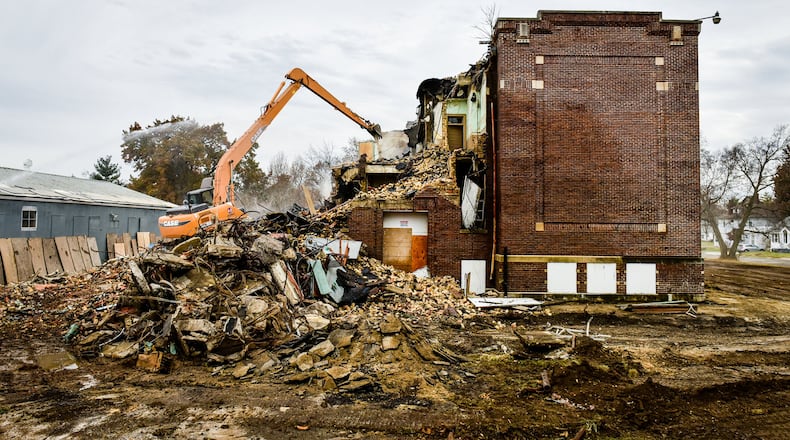A 500% leap from about 500 to 3,000 foreclosures between 1999 and 2010 prompted the establishment of the Butler County Land Reutilization Corporation, commonly known as the land bank, in 2012. There was also state money available the cities of Hamilton and Middletown wanted to tap into. In the beginning only the two largest cities were members of the land bank because they ponied up $1.1 million each in order to collect Moving Ohio Forward monies.
Today all of the cities and townships and villages — except Monroe — are members, now that the board accepted a memorandum of understanding with Milford Twp. this week. College Corner and Sharonville are not members but those jurisdictions only have little slices of land within the county.
“We’ve got a couple places that could probably use that maybe,” Milford Twp. Trustee Paul Gillespie said. “Everybody else is in, we said well we should get in too. So if something comes up you’re not out.”
Over the past decade the land bank used $2.6 million in Moving Ohio Forward money downing nearly 600 bad buildings. Then beginning in 2014 they received $5 million in federal Hardest Hit Funds for the Neighborhood Initiative Program and toppled 409 in the two big cities and a few in Fairfield Twp.
The commissioners also approved siphoning a portion of Delinquent Tax and Assessment Collection money so other jurisdictions could get help downing problem properties. So far $307,817 has been spent eradicating 11 structures.
The land bank commissioned a Miami University study in 2016 to gauge what impact they are having on the county and another in 2019. They were going to do a third, but COVID-19 descended. Secretary for the seven-member board Kathy Dudley said they did an update in-house, looking at land values in the NIP neighborhoods on the county auditor’s website.
The total value of the targeted neighborhoods in Hamilton for 2014 was $526 million and $667 million in 2020, a 27% increase. The impact in Middletown was even higher, it went from $81.8 million to $120.6 million, a 47% increase.
Since vacant structures are “magnets” for trouble they also looked into emergency responder numbers and found Middletown police calls dropped 44% from 2016 to 2020, overdose runs decreased 51% and fire calls were down 6%. In Hamilton over the same time period vacant house fires dropped 62%.
Dudley said there is a monetary impact on governments where blight is rampant and a property value and quality of life toll for neighbors near the eyesores, “what do you do when two doors down the druggies and drug dealers are hanging out on the porch and you can’t even have your grandkids over and play.”
“One of the costs the public is paying for this blight is the increased amount of service calls by fire, ambulance and police,” Dudley said. “They become a magnet for crime and so when that happens there is a police response and an enforcement response, everything from cutting the grass of abandoned properties to boarding them up, fighting fires, all of that.”
The land bank is considering creating a strategic plan, and Dudley told them recently she believes they could expand the use of the tools at their disposal.
“I think the land bank is here to stay, I think if you have state funding on a biennial basis, then I think you can perhaps use more the tools that land bank has,” Dudley said. “Not just the title clearing function... there’s a lot of tools we can use, we can help with economic development but also cleaning up some of these sites that nobody wants to touch.”
Land bank Executive Director Seth Geisler said one example is as long as the land bank holds title to a property it is tax-free which could be used as an incentive for a developer to repurpose a property, and get a bit of a tax break during the process.
Butler County Treasure Nancy Nix, who chairs the land bank board, said she thinks creating a strategic planning committee “is a terrific idea” but she wants the county commissioners — Don Dixon and T.C. Rogers are on the board — involved.
“At the 10-year mark I think the land bank has proven its value and we have gotten by on a shoe string for 10 years and have shown competency and professionalism,” she said. “It really does depend what the commissioners want to do moving forward.”
From the start she said the commissioners were “very leery about growing the landbank into another bureaucracy and interfering with the private market” and while they have been very supportive of the land bank, it will be up to them “how many tools they would allow.”
The next big thing for the land bank is an award by the state in a new grant program. When the biennial budget passed, it allocated $150 million for commercial and residential demolitions and $350 million for brownfield remediation. Each of the 88 counties automatically received $500,000 for demolition and $1 million for brownfield remediation, which is the removal of hazardous materials left when industrial blight is downed. Fairfield was awarded the guaranteed $1 million county allotment for brownfield remediation.
Geisler submitted 51 projects totaling about $11.5 million to the state on Feb. 18. The bulk of the money, would go to razing the former Forest Fair Mall. He also applied for funds to demolish 26 Hamilton eyesores, 15 Middletown properties, 4 others from Fairfield and one each from New Miami and Lemon, Liberty, Ross and St. Clair townships.
All he has heard from the state is it will be “months” before they hear about the awards.
About the Author

